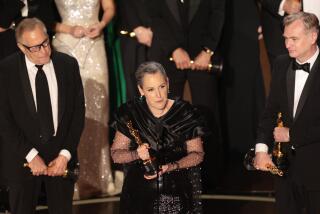Design Awards Have <i> Some</i> Value
Few weeks go by in the design community without some sort of an award program or other. Last week, it was the chairman of the National Endowment of the Arts traveling to Pasadena to hand out the Presidential Awards for Design Excellence to regional winners, having already announced the awards a few months ago at ceremonies in Washington.
This week Progressive Architecture (PA) magazine is scheduled to disclose the winners of its coveted annual awards program in the categories of architectural design, urban design and planning, and applied research, with California practitioners as usual expected to garner more than their share.
Bestowing honors in December was the Society of American Registered Architects, the Southern California chapter of the American Society of Landscape Architects, and Architectural Record magazine, the latter in a new, highly touted awards program entitled “In the Public Interest.”
And scheduled over the next few months are the awards ceremonies of the San Fernando Valley and California chapters, among others, of the American Institute of Architects, culminating with the institute’s national awards in May. Also on tap is the bi-annual Rudy Brunner Award for Urban Excellence and the tri-annual Aga Khan Award for Architecture. The list goes on and on.
I have generally viewed many of the awards programs with a certain reticence. Too often, juries have appeared predisposed and doctrinaire, influenced by peer pressure, passing fads, flashy photography, and heavily promoted personalities easily identified by signature styles. (Except sometimes to the embarrassment of the juries, it is hard to tell the masters from the mimics.) Such self congratulatory exercises can become a bore.
Still, I have found most awards programs to be of value, presenting as they do glimpses of the shifting styles and prejudices of the design profession in select geographic areas and project categories. When sitting at the design table it is instructive to know what deck the players are dealing from, and if jokers are wild.
And occasionally gems are uncovered. This usually happens when juries in fits of independent intelligence judge submissions based on a critical matrix of substantive architectural issues, such as social, contextual and structure, instead of trying to pigeonhole them according to the shifting superficial styles sanctified by a Charles Jencks, a Robert A.M. Stern, or a similar pedant.
Award programs also have the potential when properly focused, conducted and publicized to heighten public and professional awareness of the potential of good design. In addition, by honoring such efforts others involved in a particular design process might be encouraged to emulate them.
Given this potential, and the general low level of publicly funded design, I feel the Presidential Awards program deserves special mention. Presented every four years, the program honors designs in a variety of federally sponsored projects, including architecture, landscape design, planning and historic preservation.
Topping the Design Excellence list was the Vietnam Veterans Memorial on the Washington Mall, including both the expressive, intersecting black granite walls designed by Maya Ying Lin, and the accompanying realistic sculpture of three soldiers by Frederick Hart.
Other winners included the urban design of Pennsylvania Avenue in Washington, the planning of a transit project in Boston, and the engineering of a bridge in Florida. (Of the 10 top awards, only one--in Arkansas--was west of the Mississippi, indicating once again what I feel is a distinct East Coast prejudice of Washington-based programs. But that is another topic for another time.)
Locally, one of the 68 national Achievement Awards went to the adaptive reuse of the former hotel overlooking the Arroyo Seco south of Colorado Boulevard as a federal court and office building. Architects for the imaginative effort that preserved the landmark was the Pasadena firm of Neptune & Thomas Associates.
Also winning an Achievement Award was the renovation of a dated, deteriorated bungalow at 2303 Fifth St. in the Ocean Park area of Santa Monica into a desirable apartment complex. It was accomplished by the determined non-profit Community Corp. of Santa Monica and the resourceful architecture of the local firm of Fondi-Bonardi & Associates.
In bestowing a bevy of awards, the jury for the Southern California chapter of the American Society of Landscape Architects made the provocative point that the profession’s focus was in flux. It declared that “while the variety of projects receiving awards reflected the landscape architect’s broad ability to successfully design for any location, the real challenge is to create more ‘livable’ urban spaces designed with people in mind.”
To illustrate its point, the jury gave an Award of Excellence to the Santa Monica firm of Campbell & Campbell for its design of the pier area of Imperial Beach. It was noted that the design featuring the conversion of a derelict parking lot into a landscaped plaza was developed with the intense participation of local residents, in design jargon, the potential user.
Other landscape architecture winners included Dike/Runa of Newport Beach for the Hidden Oaks Ranch in Valley Center, and the SWA Group of Laguna Beach for the Baywood Apartment complex in Newport Beach.
This recognition of the “user” is heartening. And while few actual “users,” the person or persons a project is specifically designed for, are ever invited onto the juries of the various associations conducting awards program, they are, of course, the ultimate jurors, passing judgment daily on the projects experienced in their communities.
In this respect, we are all jurors, and design critics.
More to Read
The biggest entertainment stories
Get our big stories about Hollywood, film, television, music, arts, culture and more right in your inbox as soon as they publish.
You may occasionally receive promotional content from the Los Angeles Times.










